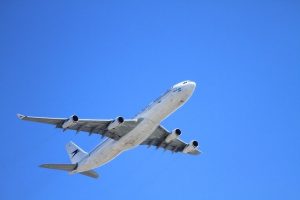 Aviation encompasses many different concepts, one of which is flight envelope. Whether propeller or jet engine-driven, all airplanes have a flight envelope. Pilots must familiarize themselves with the airplane’s flight envelope for safety purposes. What is flight envelope in aviation?
Aviation encompasses many different concepts, one of which is flight envelope. Whether propeller or jet engine-driven, all airplanes have a flight envelope. Pilots must familiarize themselves with the airplane’s flight envelope for safety purposes. What is flight envelope in aviation?
The Basics of Flight Envelope
Flight envelope refers to the flight limitations of an airplane. More specifically, it reflects the maximum speed, altitude, load factor and other parameters for which an airplane was designed. When designing airplanes, manufacturers must consider these limitations. They’ll thoroughly test the airplanes to identify their respective flight envelope.
Inside vs Outside of the Envelope
Airplanes can be described as flying inside or outside of the envelope. When an airplane flies inside of its envelope, it’s staying within the parameters for which it was designed. When an airplane flies outside of its envelope, on the other hand, it’s exceeding those parameters. Responsible pilots will strive to fly inside of the envelope at all times.
Why Flight Envelope Is Important
Flight envelope is important because it reveals the quantifiable limitations of an airplane. All airplanes have limitations. When pushed beyond its limitations, an airplane may fail. Exceeding the airplane’s altitude limit, for example, may cause it to stall. Stalling, of course, will result in the loss of lift, which will then cause the airplane to fall from the sky. Manufacturers use flight envelopes to relay the limitations of their airplanes. As previously mentioned, flight envelope consists of the parameter limitations for which an airplane was designed.
Most autopilot systems are designed to automatically stay within the parameter limitations of the airplane’s flight envelope. Airplanes won’t exceed these limitations when set to autopilot. Manually piloting airplanes, though, is a different story. Pilots must ensure that the airplane stays within these limitations. Exceeding the airplane’s altitude, maximum speed or load factor can lead to failure.
In Conclusion
In aviation, flight envelope is a set of limitations. It consists of the parameter limits for which an airplane was designed. Pilots can identify an airplane’s maximum speed, altitude and load factor by checking its flight envelope. An airplane might be able to exceed these parameters — at least temporarily — but doing so is a serious safety hazard. It can cause airplanes to stall or otherwise fail. Therefore, pilots must familiarize themselves with flight envelope while staying within its parameters.



